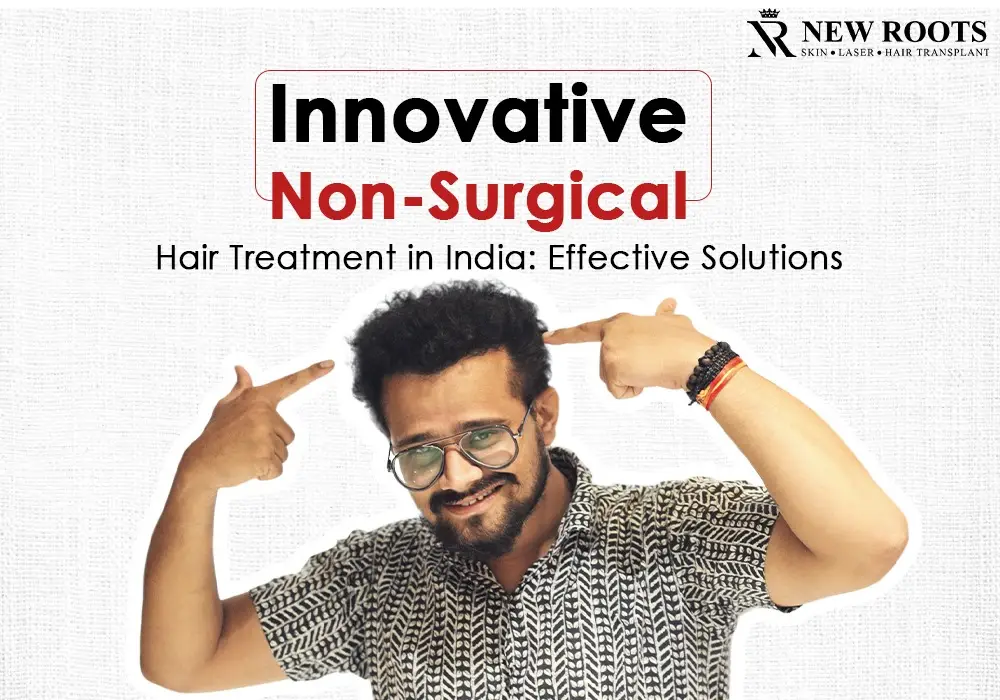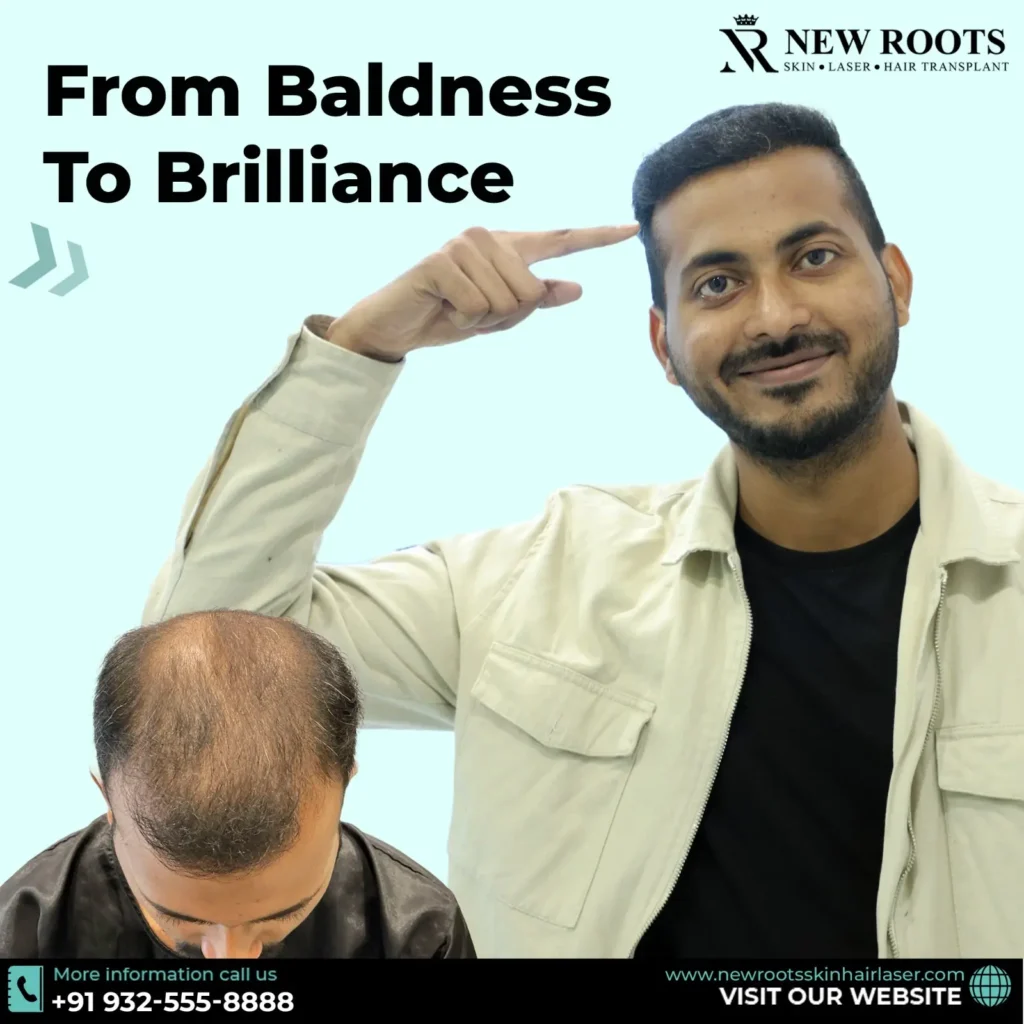Innovative Non Surgical Hair Treatment in India: Effective Solutions
Table of Contents
Introduction to Non Surgical Hair Treatment in India:
Baldness is a problem that many men and women experience in India and around the world. Though there may be several reasons, ranging from genes, hormone shifts, stress, and improper nutrition, many people seek thick, healthy hair on their heads.
Luckily, several non-surgical hair therapies have developed over the years, providing good and less destructive approaches to hair loss and rejuvenation.
This detailed and informative article will take the reader through a wide range of nonsurgical hair restoration procedures prevalent in today’s Indian market and explore their efficacy, cost, and ease of availability, along with the optimal choices by hair type.
These are some of the general treatments, and irrespective of the level of hair loss, be it just thinning hair or already having a bald head, these treatments will help you make informed choices regarding the quest for a fuller head of hair.
It is time to turn towards the way of opening up non surgical hair treatment in India.
Understanding Hair Loss: The Root of the Problem
Understanding Hair Loss:
Again, going back to the root’s definition, the root of the problem is the cause of the issue being tackled or the main source of concern.
Baldness, one of the issues that individuals face, arises from various causes and, therefore, requires one to be very careful when seeking treatment.
Most common types of hair loss:
1. Androgenetic Alopecia (Pattern Baldness):
common manifest in both the male and female populations. Melanin is attributed to our genes, but hormonal factors, particularly the hormone androgen, commonly known as the male hormone, tend to reduce the size of hair shafts. This results in male baldness, whereby the hair on the head becomes thin and recedes to as far as the edges; women experience hair thinning on the crown and on the area that parts their hair.
2. Telogen Effluvium (Temporary Shedding):
This condition is commonly precipitated by stress, such as surgery, disease, childbirth, or diet deficiencies. It results in a rapid rate of hair loss and is often initiated 2 to 3 months after some event or cause. Fortunately, this class of hair loss does not usually have a permanent effect, and hair growth might recommence at one time.
3. Alopecia Areata (Autoimmune Condition):
This condition involves the Immune system, which targets hair follicles, leading to hair loss all over the body but mostly on the head. The alopecia can be as small as some local bald patches, which can be completely or partially resolved, or it can be extensive, causing permanent hair loss.
4. Other Causes of Hair Loss:
Other Causes of Hair Loss:
Hormonal imbalances: Other factors, including; Thyroid problems and polycystic ovary syndrome (PCOS), are other causes of hair loss.
Medications: Some medication side effects will also call for hair loss; these include some chemotherapy drugs as well as some blood thinners.
Nutritional deficiencies: Hypoalbuminemia, anaemia, and deficiencies of biotin, iron, protein, and zinc cause hair loss.
Scalp conditions: Other factors include; Infection, psoriasis, and seborrheic dermatitis, which may interfere with hair growth.
Lifestyle factors: Stress is another factor that can also harm the hair as well as smoking and excessive intake of alcohol.
list the options for Non Surgical Hair Treatment in India:
Here are some of the most popular non surgical hair treatment options in India available:
1. Topical Medications:
Minoxidil (Rogaine): Minoxidil is one of those topical solutions available over the counter and effective for treating androgenetic alopecia. It seems to promote hair growth and, at the same time, reduce the rate of hair loss.
Finasteride (Propecia): Finasteride is an oral medication one takes as prescribed, and it works in cutting off the production of dihydrotestosterone, a hormone causing hair loss. It has mostly been prescribed to individuals suffering from male pattern baldness.
Other topical treatments: These include shampoos, Conditioners, serums with caffeine, saw palmetto, and niacin, among others, which are believed to help hair grow.
2. Platelet-Rich Plasma (PRP) Therapy:
PRP is a treatment most of you must have heard of, it entails taking one’s platelets and then injecting them into the scalp. Platelet contains plenty of growth factors that initiate hair follicles, and help hair growth. This is a fairly recent therapy, but studies reveal that it is effective for both male and female invasive androgenetic alopecia patients.
3. Laser Therapy:
Low-level laser therapy (LLLT) is the application of specific low-intensity light over the dermal papilla of the hair follicles to increase hair stimulation. This therapy is usually contact-free and can be administered in a clinic or at home using equipment.
4. Hair Transplantation:
This procedure involves moving hair follicles from a donor site, which is normally the back of the head, to the by-regions. It is a surgical intervention, but it is described as non-operative management since scalps do not undergo any incisions.
5. Ayurvedic Treatments:
In the Ayurvedic system of healing, various solutions are available for treating hair loss, including medicinal plants, pressure applied to various parts of the body, and changes in diet. Thus, the following Ayurvedic herbs are widely recommended to treat hair loss: amla, bhringraj, and Brahmi.
6. Other Options:
Mesotherapy: Application of vitamins, minerals, and other nutrients under the scalp's skin to stimulate hair growth.
Microneedling: This technique involves the use of very thin needles and it is partly performed to cause small punctures normally referred to as micro-injuries on the scalp to enhance the production of a certain protein called collagen and also encourage hair growth.
Scalp Micropigmentation: In this process, a pigment similar to that of a tattoo is imprinted on the scalp to resemble hair.
Remember: This may mean that the best nonsurgical hair treatment option for you will depend on various issues, such as the cause of hair loss, the basic needs of the user, and even the financial standing of the client. In this case, you should consult a dermatologist or trichologist to understand how to address the problem.
7. Derma roller
Derma rollers are used for a treatment process known as micro-needling or skin needling. This therapy induces collagen. Thousands of highly tiny "micro-medical" needles are embedded throughout the roller, causing multiple minor micro-injuries to the skin.
Hair Growth Serums and Medications: A Powerful Duo
There are many over-the-counter topical solutions and some oral treatments that can be worn or taken to help slow hair loss. Finasteride and Minoxidil, also known as Rogaine and Propecia, are some of the most common and effective drugs.
How They Work:
Minoxidil :
This topical solution must be applied to the scalp area of the head. Its mechanism is the activation of hair growth and prolongation of the hair cycle stage called anagen. This means that hair remains in the growing phase longer and appears thicker and denser.
Finasteride :
These drugs are usually swallowed orally and taken as a daily dosage. They do this by stopping the synthesis of dihydrotestosterone (DHT) in the body, a hormone that causes the hair follicles to minimize, leading to baldness. Indeed, by lowering the DHT concentration, Finasteride will halt further hair loss and may also support hair regrowth.
Benefits of Hair Growth Serums and Medications:
- Clinically Proven Effectiveness: Minoxidil and Finasteride are both clinically tested drugs to show results on pattern baldness or androgenetic alopecia in both genders.
- Ease of Use: Topical formulations are easy to use daily because they are oral medications that can be taken easily.
- Non-Invasive: All of these treatments are nonsurgical hence giving an advantage to those who do not want to undergo surgery.
Important Considerations:
- Results Take Time: Most of the time these treatments can take up to three to six months before there is improvement that has been noted.
- Consistency is Key: It is, therefore, important to continue using it to sustain the result obtained. ” It is important to continue taking the treatment even if the hair loss has stopped in order not to experience the regrowth of the problem.
- Potential Side Effects: They are generally safe, though both Minoxidil and Finasteride have side effects. You should consult your dermatologist about the cream’s higher risks and side effects.
Costs and Accessibility of Non Surgical Hair Treatment in India:
The Price Structure and Usability of Non surgical Hair Treatment in India
India’s non-surgical hair therapies provide different choices for patients with hair-shedding issues; the costs may also differ by treatment, clinic, and region. Here’s a general overview:
Treatment Costs:
PRP Therapy: INR 5,000 to INR 15,000 per session
LLLT Devices: Rs. 10000/- to Rs. 50000/- (one-time fees)
Mesotherapy: For the commercial and larger sessions, INR 2,000 to INR 10,000 per session
Hair Growth Serums & Medications: INR 500 to INR 2000 per month That is usually ongoing.
Treatment Costs:
These non-surgical treatments are widely available across major Indian cities, including These non-surgical treatments are widely available across major Indian cities, including:
Mumbai
Raipur
Bangalore
Kolkata
Many clinics focus on hair-related issues and currently provide many hair loss solutions depending on the client’s requirements and affordability.
People Also Ask:
Headz Hair Fixing cost starts from Rs. 15,000/-.
The price of fixing the hair patch also depends on the extent and area of the hair loss. Also, it depends on the type of hair patch you choose, whether it is
1) Natural human hair
2) Machine Hair,
3) a Mix of machine-made and human hairs
How Long Will My Non-Surgical Hair Replacement Last? We advise that our non-surgical hair replacement system will last between 4 and 6 months however, with the right care and maintenance, it could last longer. You may need to visit your local Blonde Envy by ZIGZAG salon for touch-ups and refits.
The clips or glue utilized are cosmetic; therefore, there are no side effects from the hair patch.





